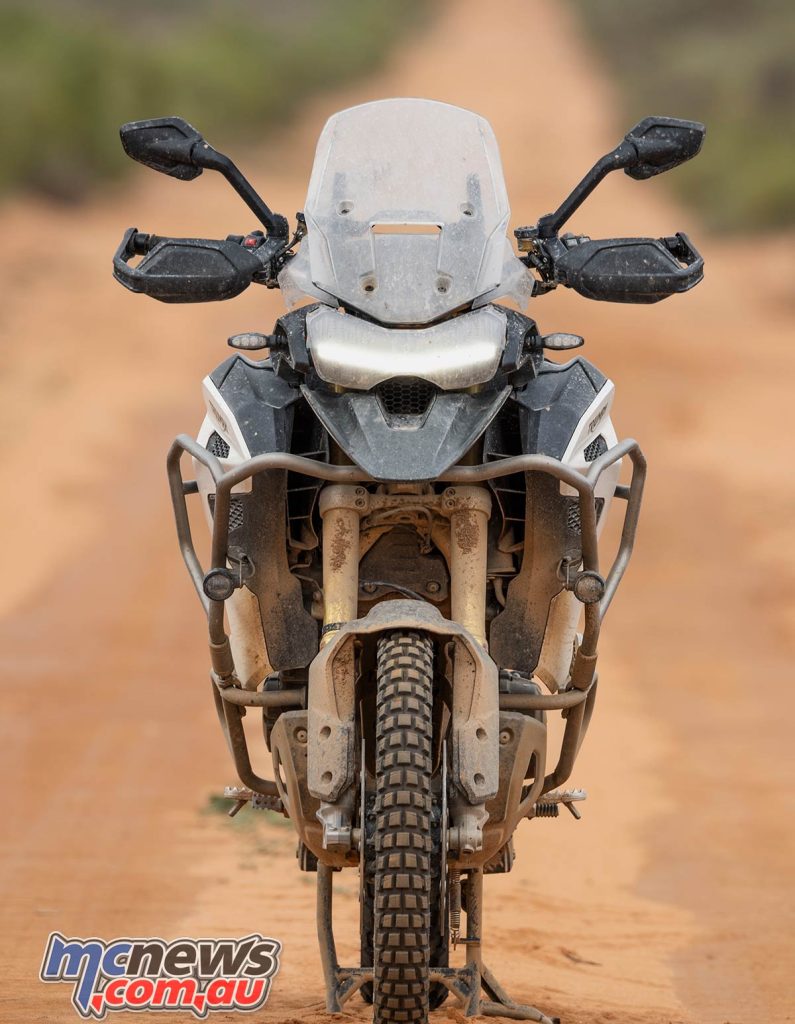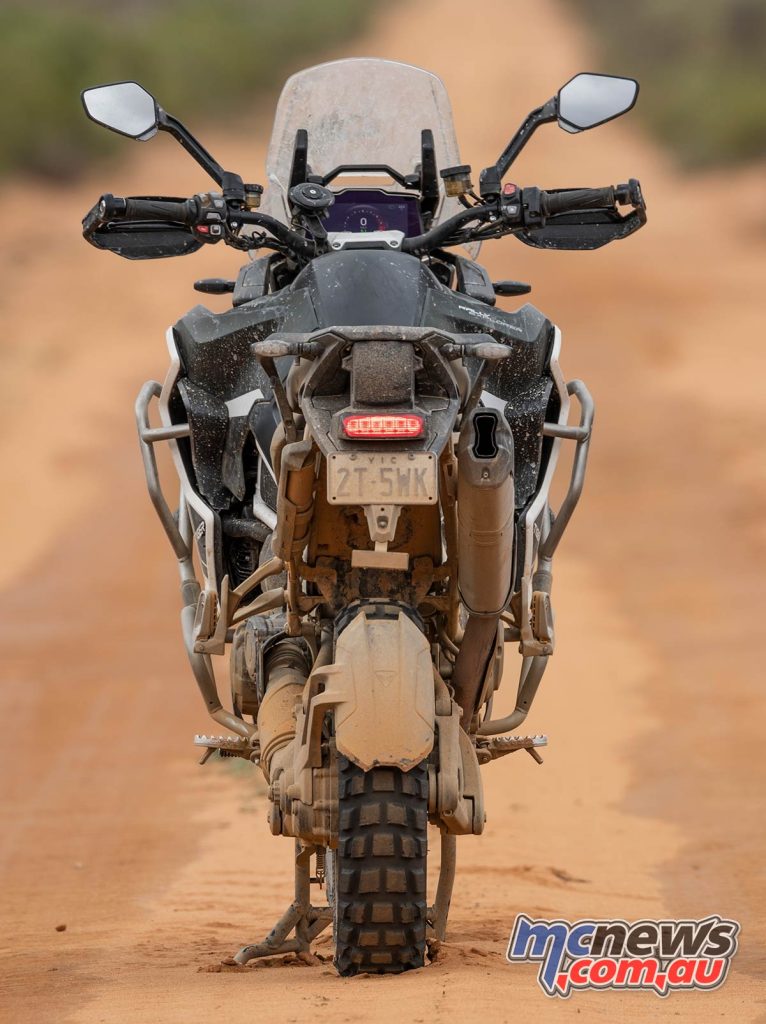2022 Triumph Tiger 1200 Review
Review by Wayne Vickers – Images Dean Walters
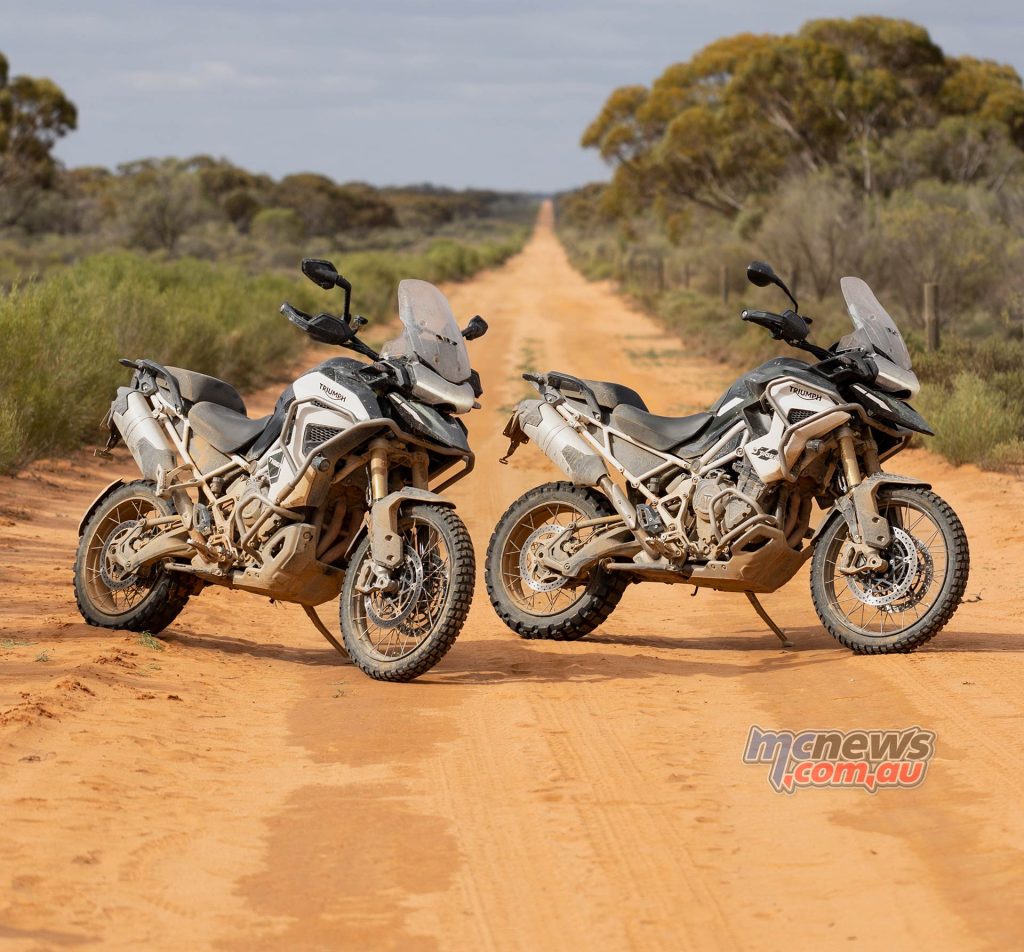
It says something about Triumph’s confidence in the new Tiger 1200 platform that they green-lit a five day, 2,000 kilometre Australian launch through the dust and rocks (and mud!) of the Flinders Ranges. In isolation it’s a big enough deal, but the observant will have spotted that it followed a few other notable activities… It came hot on the heels of Ivan Cervantes Baja win on the Tiger 900. That was followed by Cam Donald completing the South Oz 24hr endurance trial on the Tiger 1200 (and in doing so, becoming the first ever large capacity bike to finish that race). And of course we know that Cervantes and Ricky Carmichael are helping develop the upcoming MX and Enduro range… Think they’re getting serious about all things off road? You better believe it. They’re certainly racking up some credibility points of late.
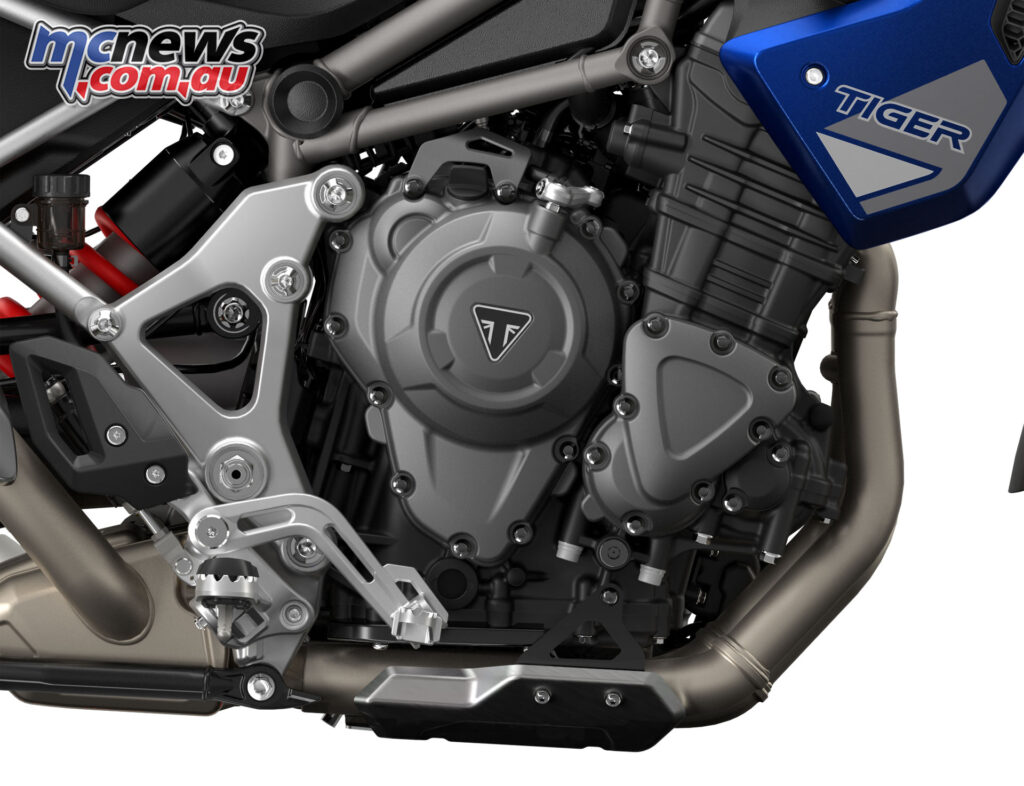
Now I’ve made no secret of my love for the triple-cylinder engine. My own personal Tiger 800XC is approaching 300,000 kilometres and has served me more than well, delivering a metric shipload of grins, both on and off-road. And just as that mid-capacity model has been refined over time and evolved into the outstanding T-Plane 900 platform, they’ve now taken those learnings and given the same treatment to the 1200.
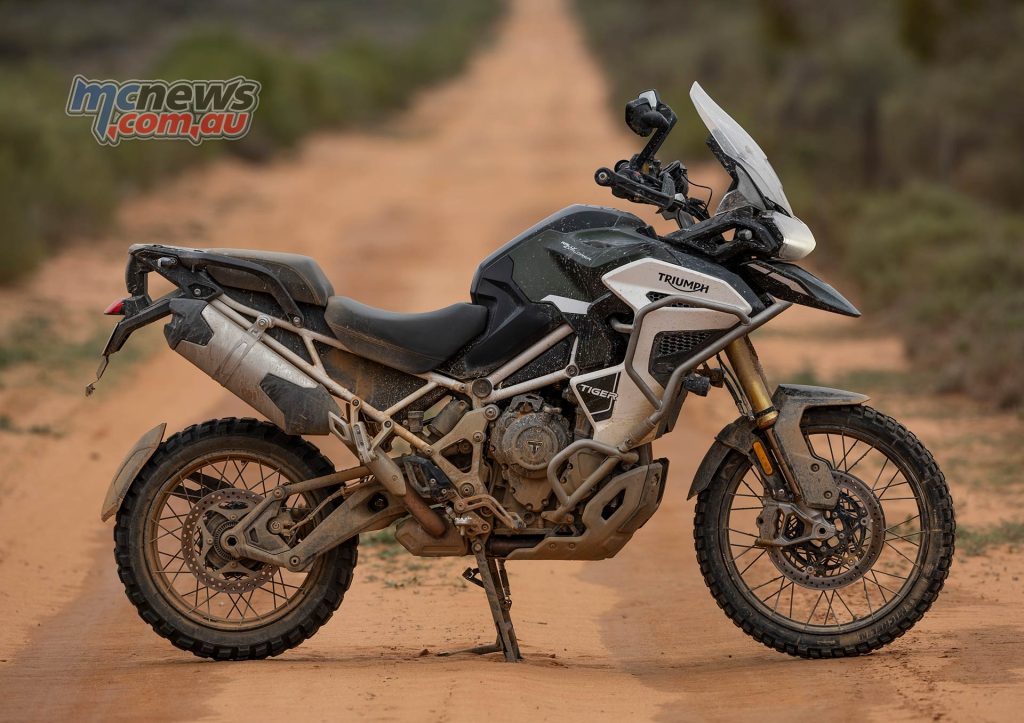
While the first Tiger 1200 model was a solid enough debut, the new one is nothing short of a quantum leap forward. It’s now a genuine contender with major updates across the board. The single swing-arm has gone the way of the dodo in favour of a trick tri-link setup. It now has an updated semi-active suspension, more power and a raft of updated electronics. The styling has been given the Rally Pro treatment too and to my eyes it looks the business. That trellis frame is just lovely and now has a bolt on Alloy sub-frame. But most importantly, in what is arguably the biggest indication of intent – it’s dropped a massive 25 kilos. Twenty-five!
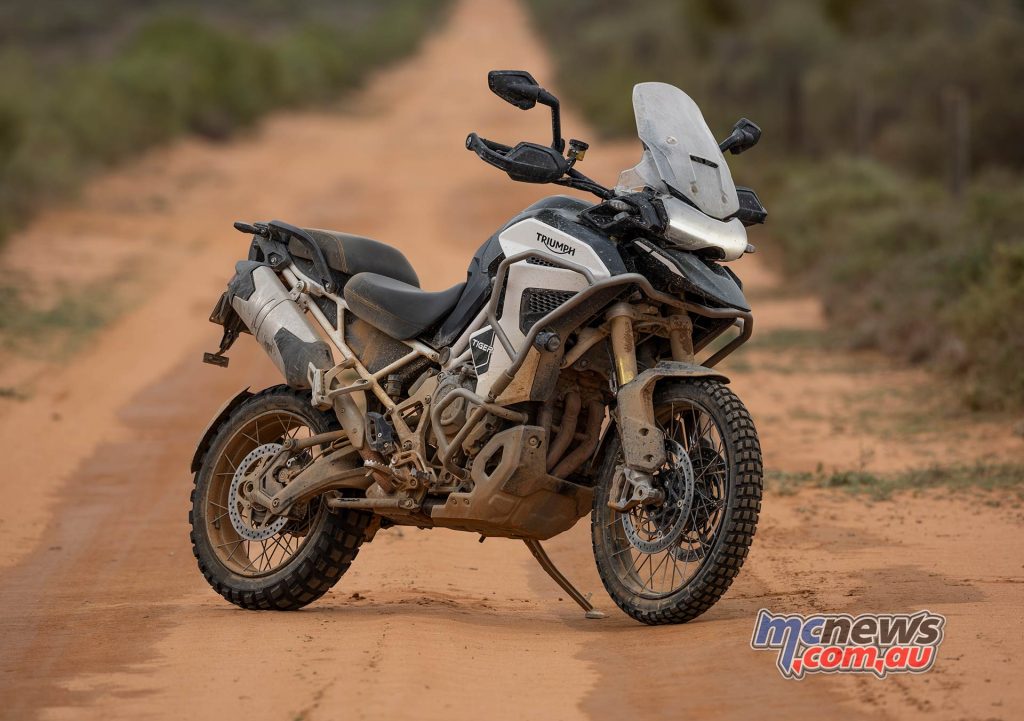
That now brings it in at 249 kg (full of juice) for the Rally Pro model which comes with the 20 L tank, and 261 kg (full of juice) for the Explorer model with the 30 L tank. This bike feels a lot less top heavy than its predecessors and it is now quite competitive with its closest European rivals. A couple of kilos lighter than the 1250 GS Adventure, but with quite a few more ponies; pretty line-ball with the chain-driven KTM 1290 Adventure R and Ducati Multistrada V4 S on the scales but a little behind the Austrians and Italians in the engine department. The only full sized adventure bike with a 21-inch front that tips the scales lighter by any real degree is the base model Africa Twin, but the Honda gives away a lot to the Triumph in the engine department.
Without dwelling on it too much (I mean it IS a big deal), that weight loss program was a major part of their goal to build the most agile and manoeuvrable full size adventure bike available. And while I haven’t ridden them all back to back, I can tell you that it is more than in the ballpark. It’s a ripper.
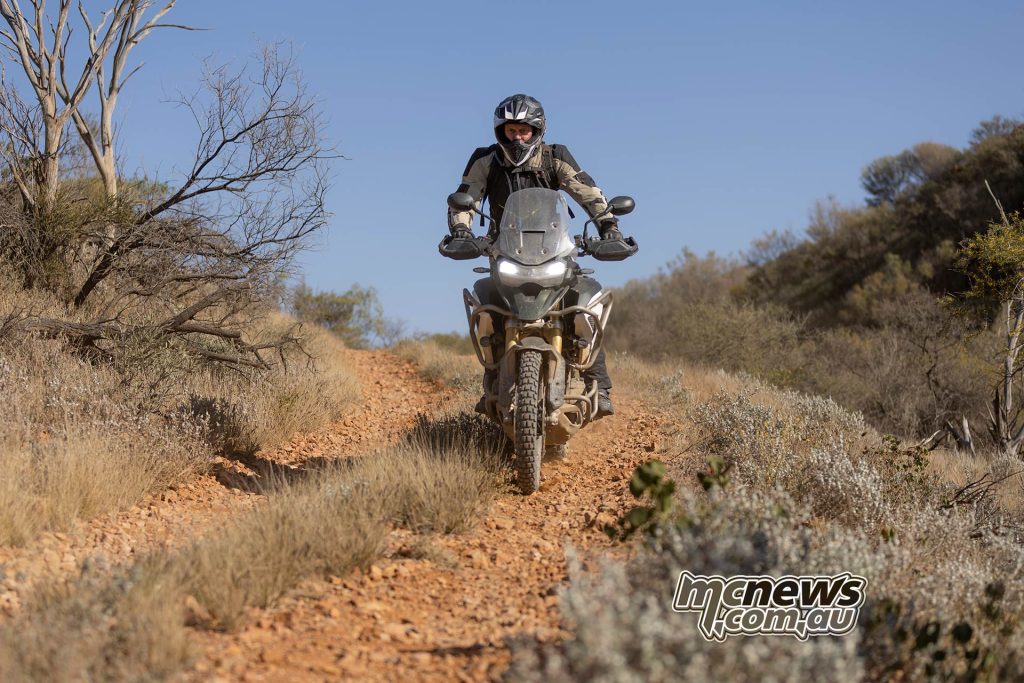
Another major ingredient in the handling recipe is the introduction of semi-active Showa suspension front and rear, replacing the previous WP kit. 49 mm diameter forks, with 220 mm travel on the front and the rear. It’s plush, yet controlled and happily soaks up all but the hardest hits without fuss (we’ll get back to that). No, it’s not going to hit 20 metre jumps like you see in that video with the GOAT on board, not with standard springs anyway, but for what most of us are going to do on these full sized platforms – it’s pretty ace. It comes with nine pre-defined but adjustable damping settings for each riding mode. As in, the scale of each of the nine settings is different for each mode. Smart.
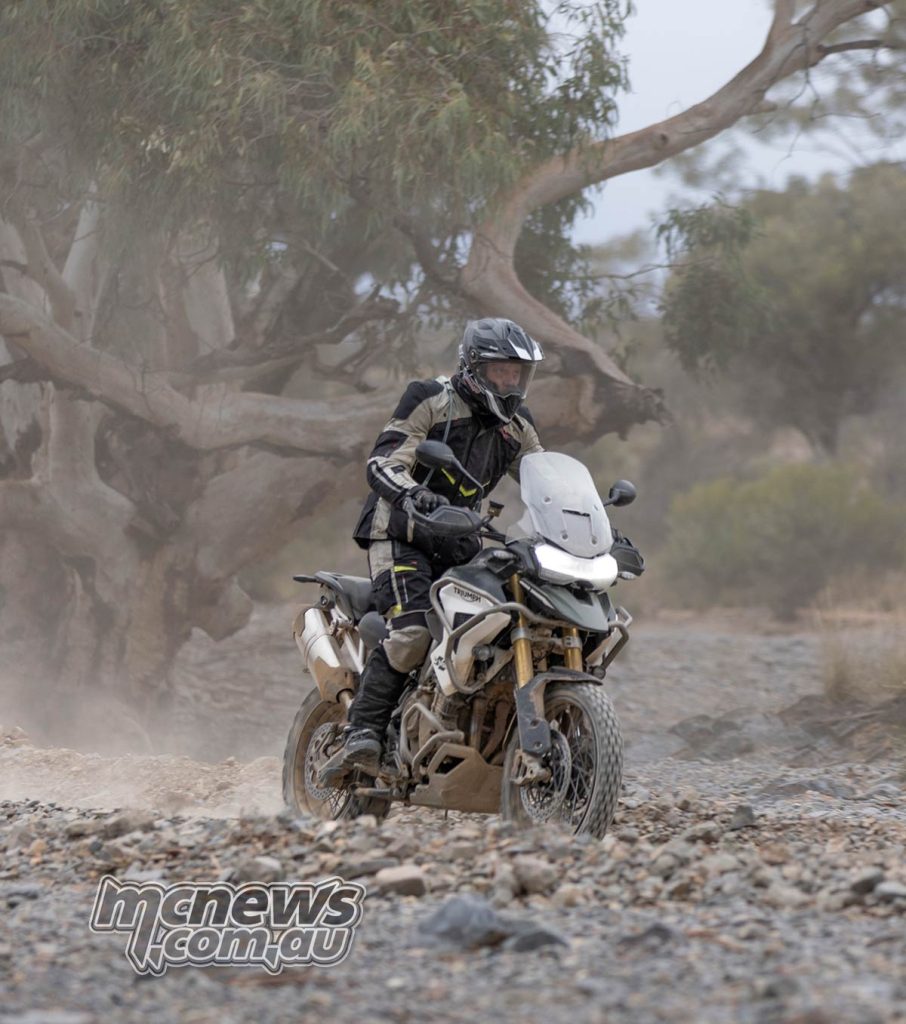
Back to the week of some of the best riding I’ve had the pleasure of ripping into. We started out from Adelaide on a cold and blustery morning. Riding out through the hills and fog through some very slippery green moss covered damp roads. Road mode (~125 hp) proved its worth here, the traction control kicking in a couple of times as I accelerated past traffic and crossed white lines – giving me a good indication of where the limits were on the Tractionators fitted to my bike.
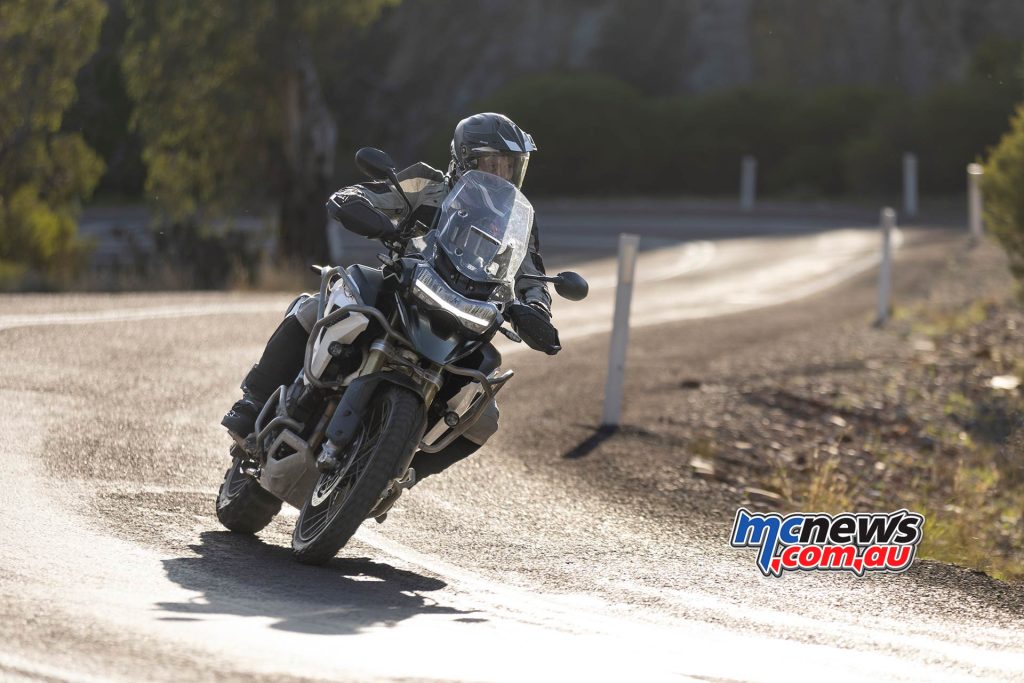
Worth mentioning too that my bike was actually the sister bike to the one Cam rode in the 24hr race. This one was punted hard by Donald Owen and ultimately didn’t finish after sustaining crash damage to the front cowl and dash unit. But it was absolutely punished for 16 hours before bowing out. I’m told he was running an even hotter pace than Cam which means he must have been really ripping along because Cam’s not exactly a plonker… So they got it back to the shop, gave it a wash, threw some new cowl panels on it and handed me the fob. Did I mention they’re confident in the driveline durability?
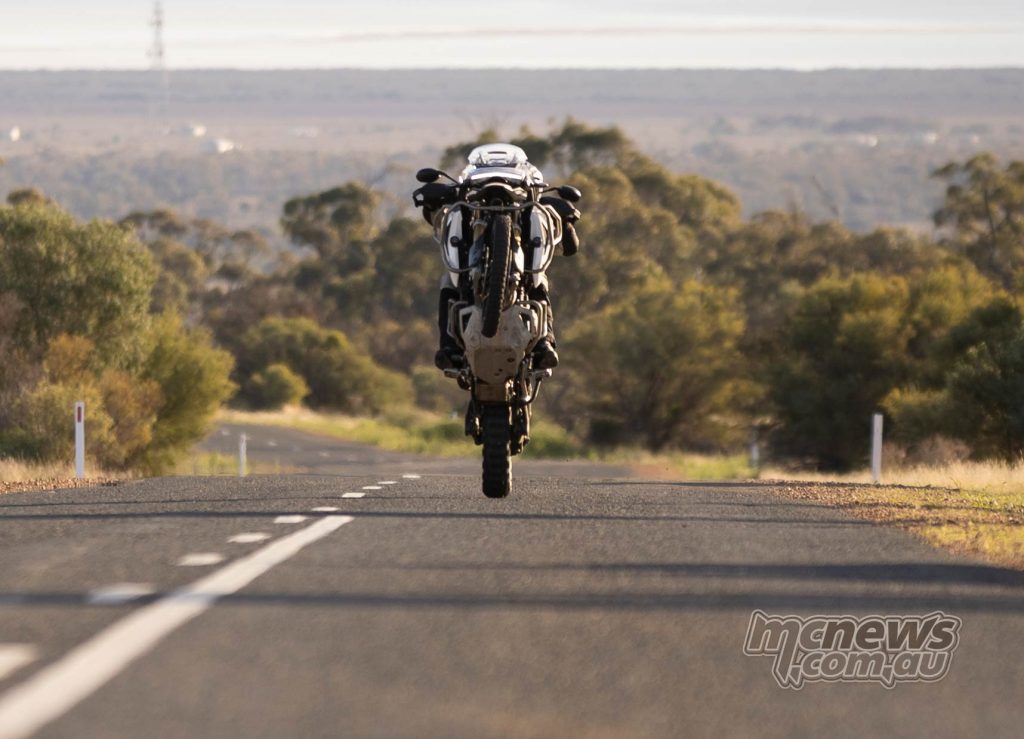
After lunch we got a chance to push the limits on tar, where the road manners impressed me greatly. That chassis delivers. Big time. For a bike with a dirt oriented 21-inch front wheel, it corners instinctively well on tarmac and provides amazing feel for what’s going on underneath you. The lovely trellis frame has tremendous mechanical grip levels. Of course there’s no getting around the fact that it’s still a big bike, but it’s certainly agile. Handling to me seemed ‘just right’. Beautifully balanced front to rear.
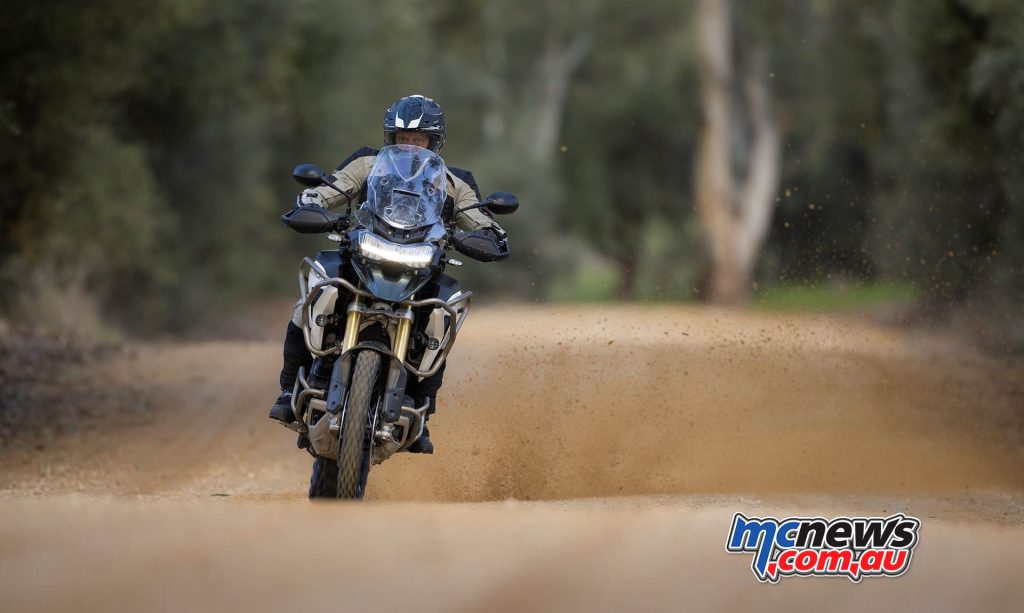
I was giving Nigel from PSI (Aussie Triumph Distributors) a bit of a hurry up through this section and we were both sliding around on the knobbies – front and rear. For a big bike it was super predictable and fun to explore its limits. I was almost convinced the road was damp through that section as we were walking the bikes around quite a bit, backing into turns, sliding out. Turns out we were just running a pretty warm pace. The first of many fist bumps for the trip were had at the end of that run. Just glad I was not paying for the tyres…
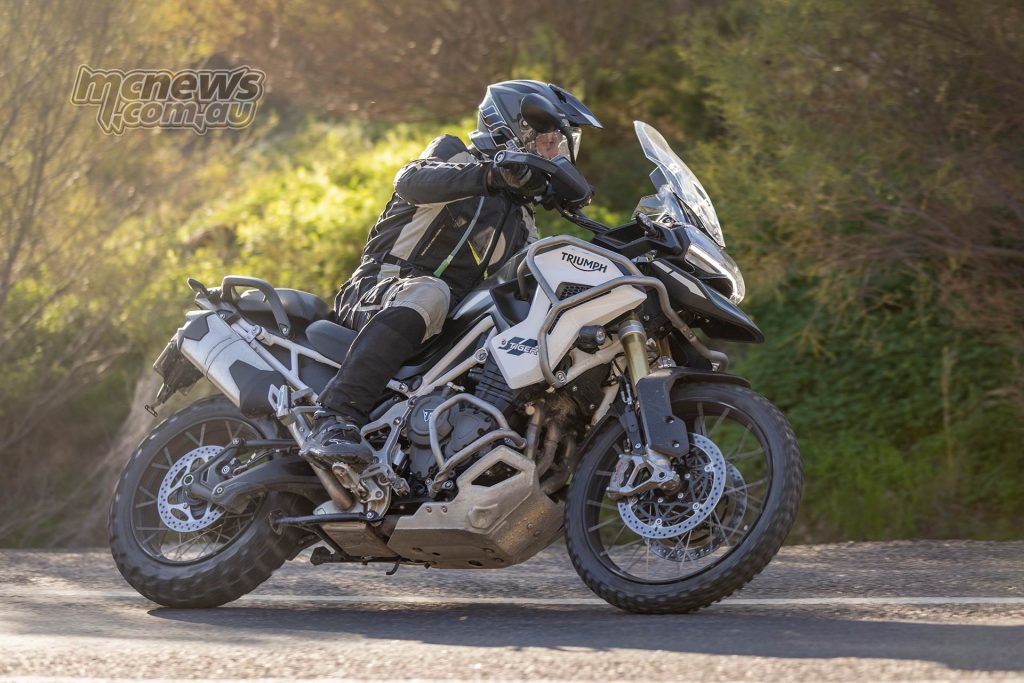
I’d actually flicked it into Off Road Pro to disable the traction control prior to that section, so wicking it up on corner exit was easy and predictable. Off Road Pro mode allows that – as well as allowing you to disable ABS if you want. I generally like to keep ABS on the front but not the rear, both on and off road – so I found myself in Pro mode quite a lot…
You can also fine tune the engine maps within each mode if you like. So it’s entirely possible to run Sport map giving you the full 150 ponies within Off Road Pro mode. Which I tried after that run. Can confirm its fun. Can also confirm that it allows you to loft the front quite easily… Over obstacles of course. There are some long obstacles out there I hear. So we practiced a bit of that just in case something came up.
That ABS works nicely on the front too. Now with cornering-optimised six-axis sensing electronic smarts. Worth mentioning those brakes a little more actually. Brembo Stylema 320 mm jobbies up the front, so you know they’re going to be ace, but what I didn’t expect at first was the subtle linking of brakes front and rear. Engage a little of either and you’ll get some of the other.
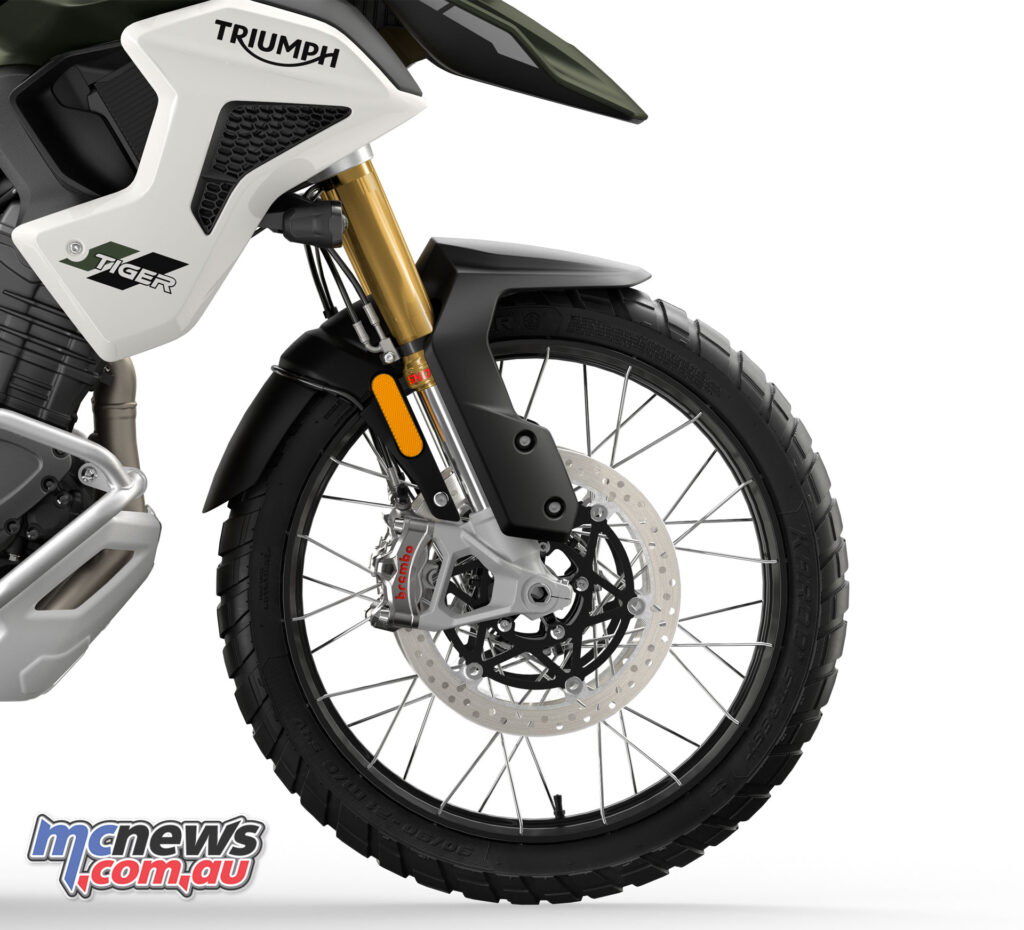
I’ve sampled previous generations of linked brakes that kinda-sorta-didnt work as well as they promised, but that’s not the case here. I loved them. For a few reasons. On the road when punting along I tend to lean on the front end pretty hard and didn’t need to use much rear from the pedal at all – the bike was just so stable. I wasn’t aware that the bike even came with linked brakes initially, but had it confirmed after that leg. I’d been surprised by how strong the rear alone had felt earlier in slow traffic. And then surprised again when I was really starting to wick it up and trail brake into corners, as it felt like it was holding a line as though I was dragging a little rear. Lovely. It was also ace in the dirt later in the ride on tricky descents where I didn’t need to ride the rear brake. I could just rely on the front ABS for 80 per cent of the time, only using the rear if I needed to stomp on it and lock it up.
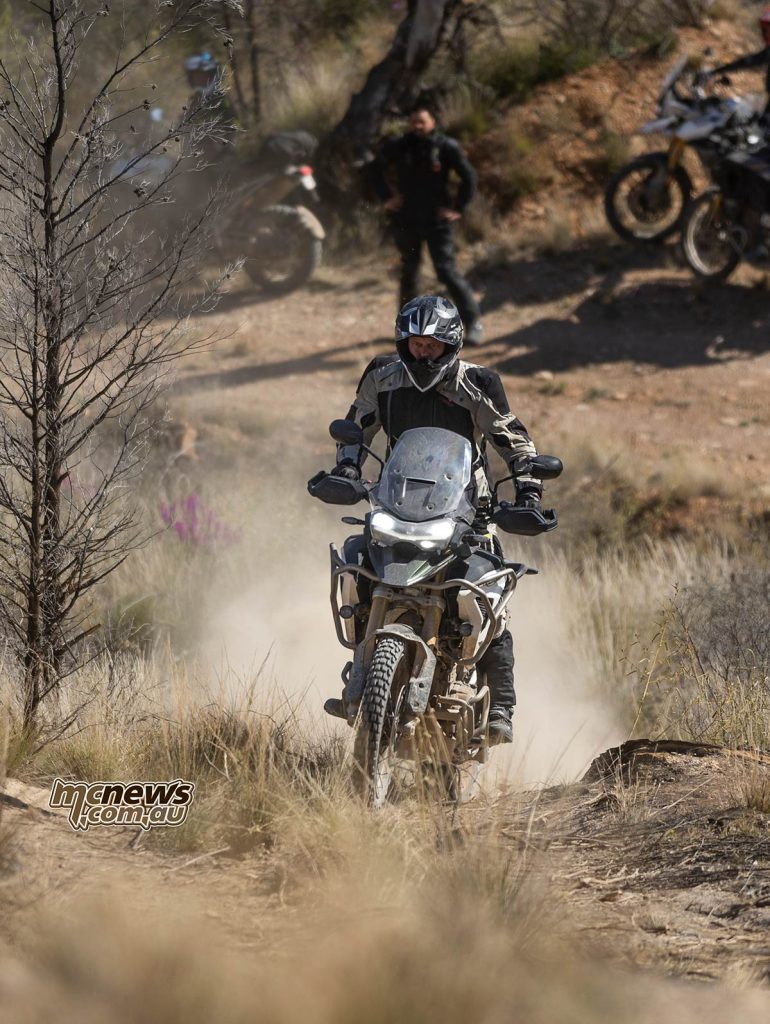
From there we headed off for our first taste of dirt as we headed up Bridle Track. It was a great opportunity to get our head around what sort of pace to run – what gear, what revs. Turns out that the motor happily lugs up a hill from as low as two-and-a-bit-thousand revs, so I found myself rarely using first gear except for the steepest and roughest of pinches. As the ride progressed it became apparent that second to fourth in the dirt was the sweet spot. We stopped here for a couple of these nice ridge top sunset shots and then continued on to Port Augusta for the night.
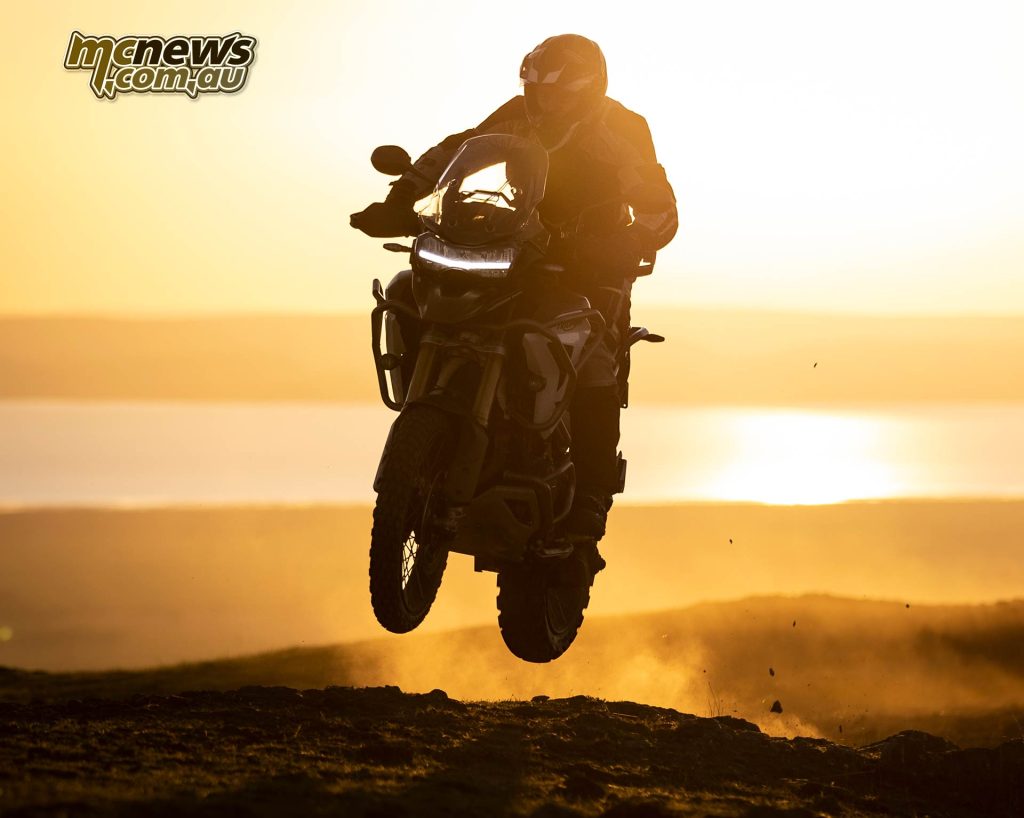
Day two dawned windy and threatening with some light rain. We hightailed it out of Port Augusta at a healthy pace – it eeeaaats up road kays. Before long we did in fact hit some rain, just as we turned into the first dirt tracks of the day. Rain in the Flinders Ranges.. what odds? Good thing that front screen is quickly adjustable on the fly – the whole front end providing oodles of weather protection and we arrived at the dirt section pretty much dry. And promptly slid the screens back down.
Turns out the yellow clay sections out there are bloody slippery when wet! With quite a few of us having unintended slides at either end, the pace was rightly cautious. I actually moved it back into Off Road mode after the first stop here to test it out and admit that I enjoyed the security blanket of traction control. It did its thing nicely, allowing a little bit of slip and then getting things back under control. Fortunately the rain didn’t last long and before lunch we were back in optimal conditions.
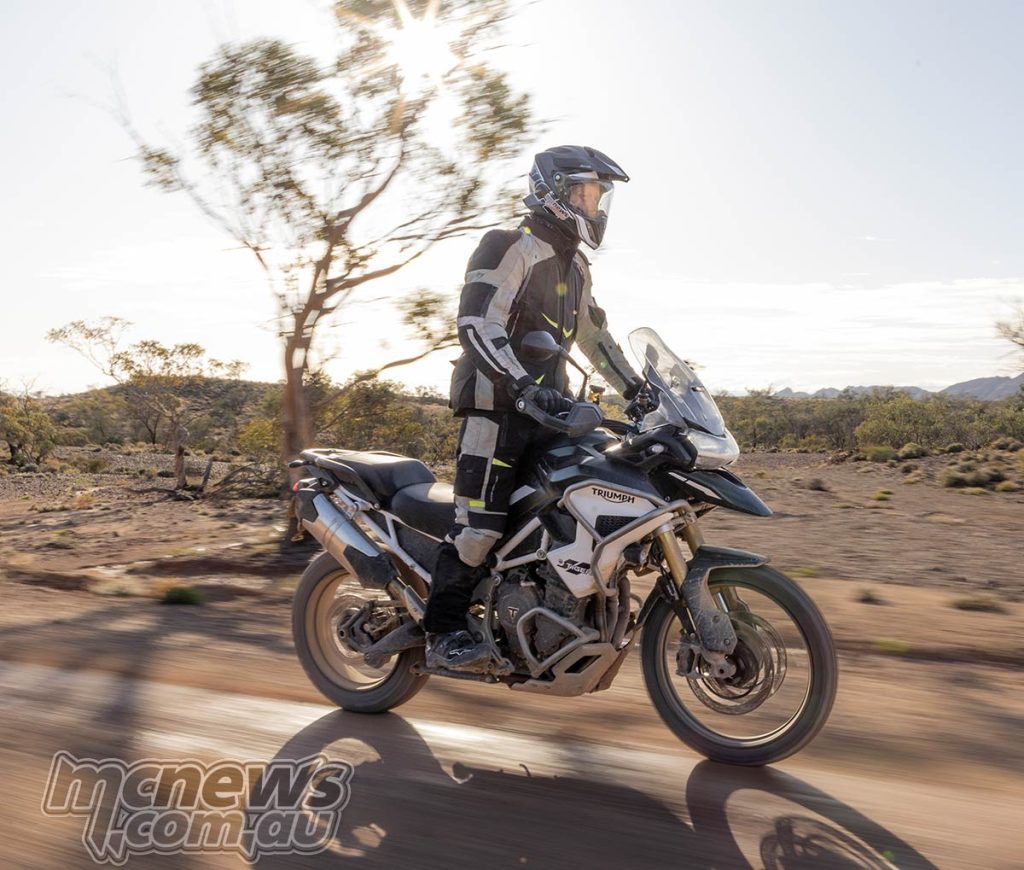
I’d rolled the bars forward a little overnight knowing we had lots of dirt to do and it was paying off. It all started to click. The standing ergos of the 1200 proved to be probably the most naturally comfortable of any bike I’ve ever ridden. My knees dropping into place just forward of the seat tank junction allowing a great, relaxed stance. Incredibly easy to get your weight over the front a little on corner entry and then spin up the rear on exit. That excellent chassis makes for a front end that feels super planted. Magic. Listening to that big triple spin up from three or four thousand revs as it starts to lose traction is just nirvana. Glorious. The T-plane crank making the big banger sound more V-Four like than V-Twin. For a bike with a stock muffler on it, it’s pretty epic.
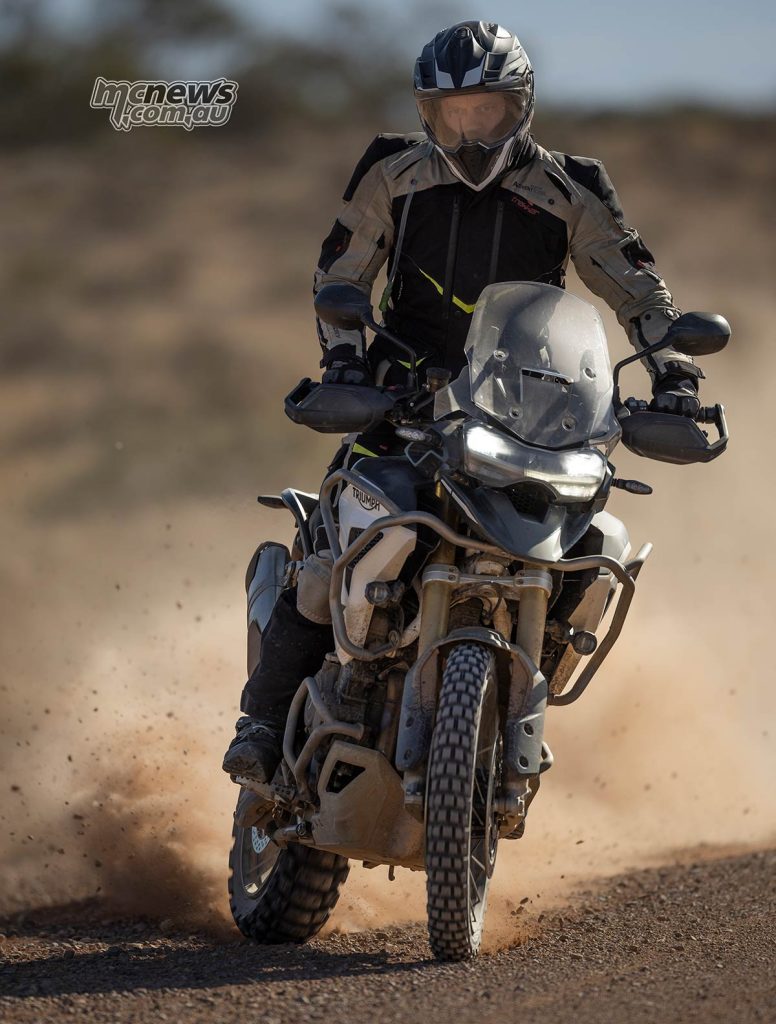
Third, fourth, fifth gear slides on smooth gravel sweepers. Bring it. Shit eating grins and more fist bumps. And then we hit a slightly tighter double track section and it went up another level. By now we’d pretty much dialled ourselves into the bikes and each other. Throughout that afternoon a few of us rode side by side on that double track, at reasonable pace. Completely confident in the bikes and each other’s ability not to stuff it up the inside and ruin the fun. It was up there in terms of riding bliss. Smooth, flowy mostly second and third gear with the occasional floodway crossing keeping us on our toes. Slow for a bend, flick it in, balance through the corner spinning up on exit, up a cog, skid some more, synchronised wheelies over bumps. Rinse and repeat. It doesn’t get much better. More fist bumps. Silly grins and shaking of heads.
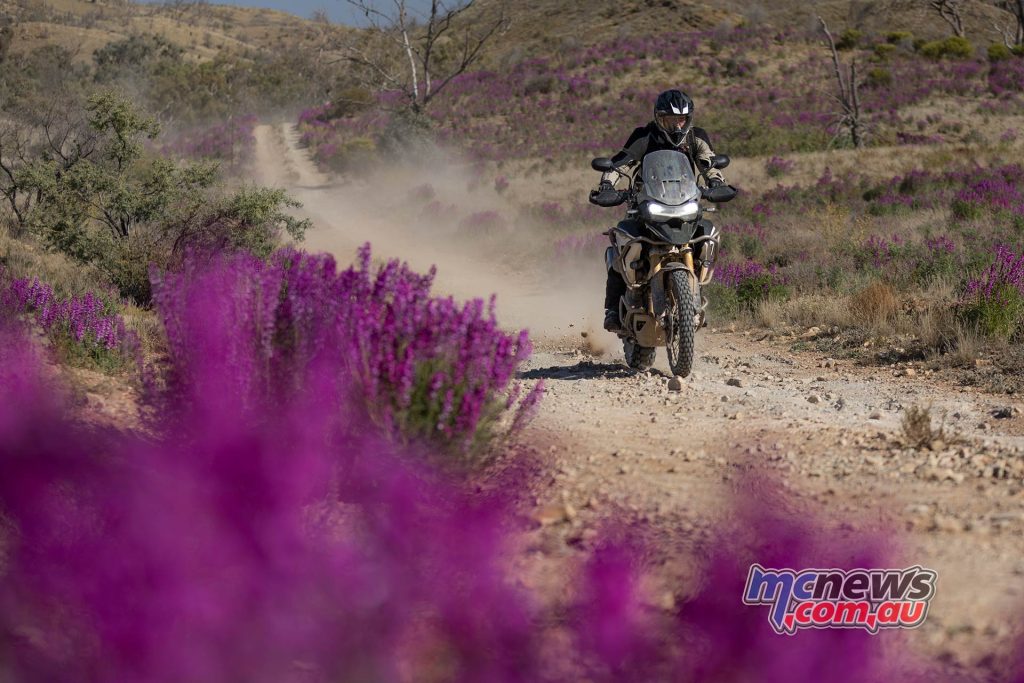
Day two ended with us coming into Arkaroola dodging the occasional Kangaroo in the dark. In the rain. On more of that slippery freshly graded yellow clay stuff. Didn’t matter. The beers tasted pretty special… Great day.
Day three we arguably pushed the bikes outside of their design brief just to see what was possible. Quite a challenging 88 km loop around Arkaroola that took us most of the day to get through, taking into account photo and video duties and a couple of punctures. We had rocky descents with drops big enough to case out the bikes at times, floodways and riverbeds, twisty, rocky and sandy climbs. Grip levels were good mostly, but occasionally unpredictable. What did I learn? It’s pretty surprising just what you can tackle on these things… Absurdly capable and fun. Oh – and Off Road mode can be good to add a little TC at times, but probably not when attacking a steep climb with a mix of sandy loose bits and rocky bits – you will lose momentum in the sandy bit… I did make it up though.
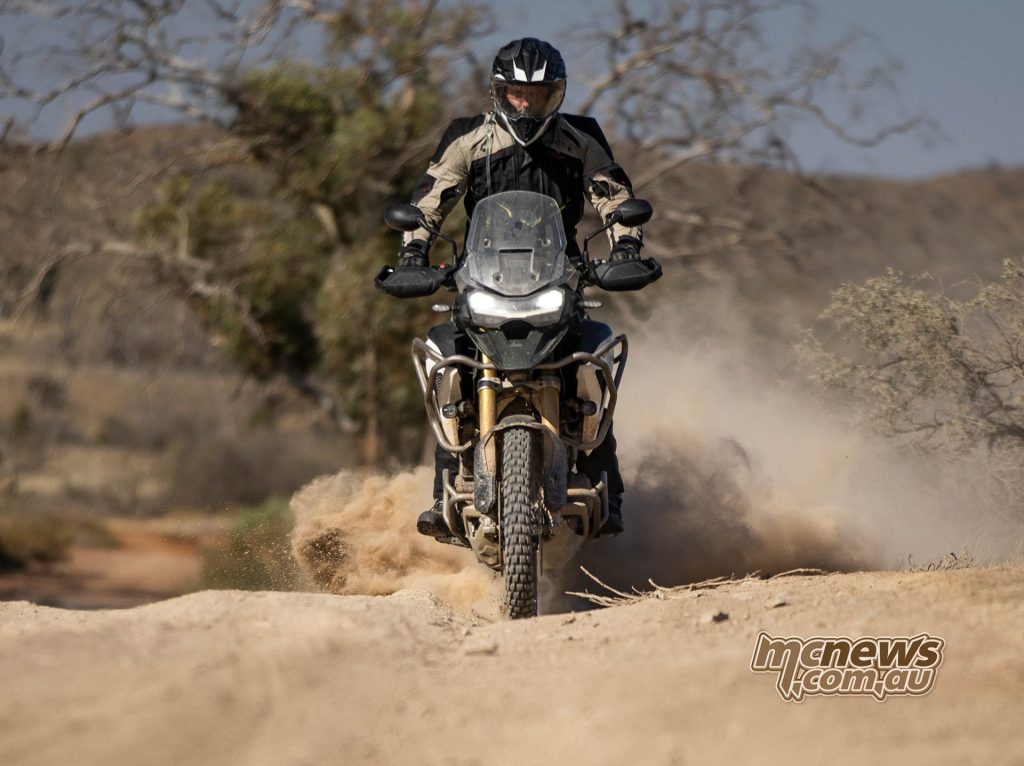
Incidentally I switched the seat height from low to high on this day and left it there. 20 mm higher, adjusted in about 30 seconds with no tools. It moves the seat height from 875 mm to 895 mm with no real downside to freedom of movement on the go.
I’d been running the suspension in its second firmest setting since the end of day one and felt that it was mostly a good mix of comfort and performance. But this loop could have used some more spring in the rear and some quicker rebound, especially on some of the rocky bumpy climbs and lips. If I’d had the option to go firmer I would have. On some really choppy climbs the rear would not quite keep traction as well as it could have done with some stiffer springs. And the bigger hits and jumps found the end of the travel at both ends. What I did notice though was that even when you did occasionally bottom out, the consequences were negligible. You didn’t get thrown off line or flicked forwards over the bars, it just settled smoothly and carried on… With the stock spring, that trick new tri-link swingarm works well in all but the most extreme conditions. It does add a few minutes to the process of swapping out a rear tyre though. But that’s not a big deal in my eyes.
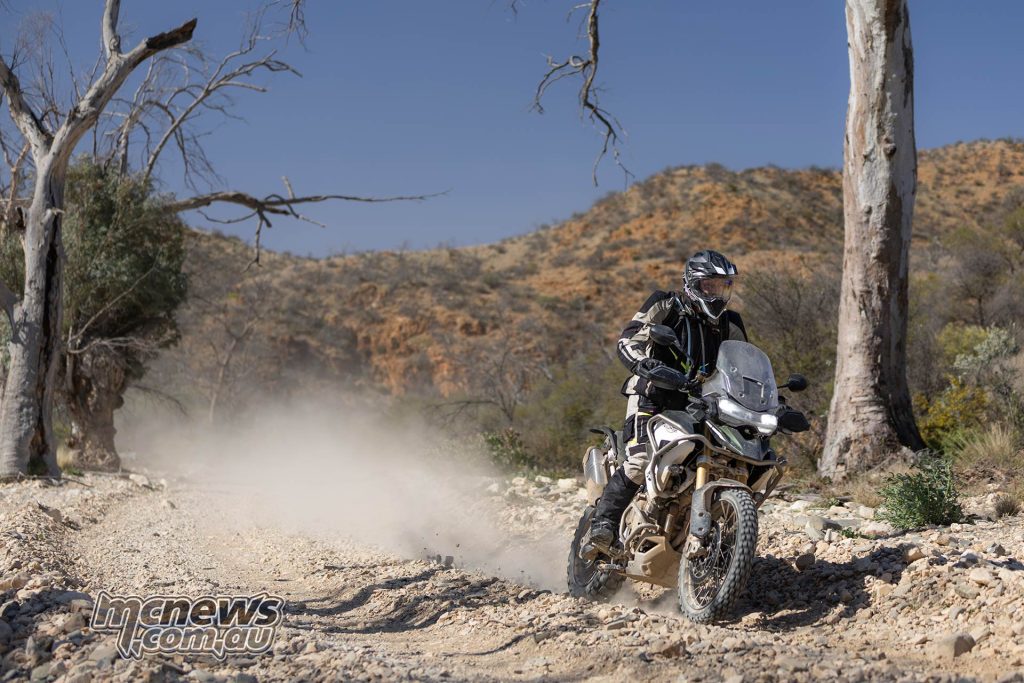
Thinking about the suspension further, I dunno if you’d want to push them a whole lot harder than we were anyway, for fear of potentially dinging a rim. So.. maybe it’s a bit of a self preservation handbrake. For reference I’m 85 and a bit kegs, so with all my gear and a water bladder – gotta be close to 100 kilo all up? On top of a 250 odd kilo bike. If you want something to fully launch off erosion mounds, you’re probably not going to be looking at a full size Adventure bike anyway are you? So while I’d have liked it a bit firmer at times, it’s not a show stopper. It’s a compromise.
It’s pretty clever that semi-auto suspension – self-adjusting pre-load to whatever weight you load up on the bike. So if you happen to jump on a lighter rider’s bike, on start-up it pops up a little message saying that it’s ‘adjusting pre-load for fat blokes’. Or something to that extent.
Day four delivered more sublime gravel roads, from Arkaroola we back-tracked a bit and made our way to Peterborough (the one in SA, not the one on the Great Ocean Road…). Similar conditions to day two. Over 450 kilometres of gravel roads, some gated farm tracks, some tarmac, some sandy roads. It positively ate up the kays. With such vast distances to ride in this great country of ours, it became more and more apparent that these big bikes are perfect for this stuff.
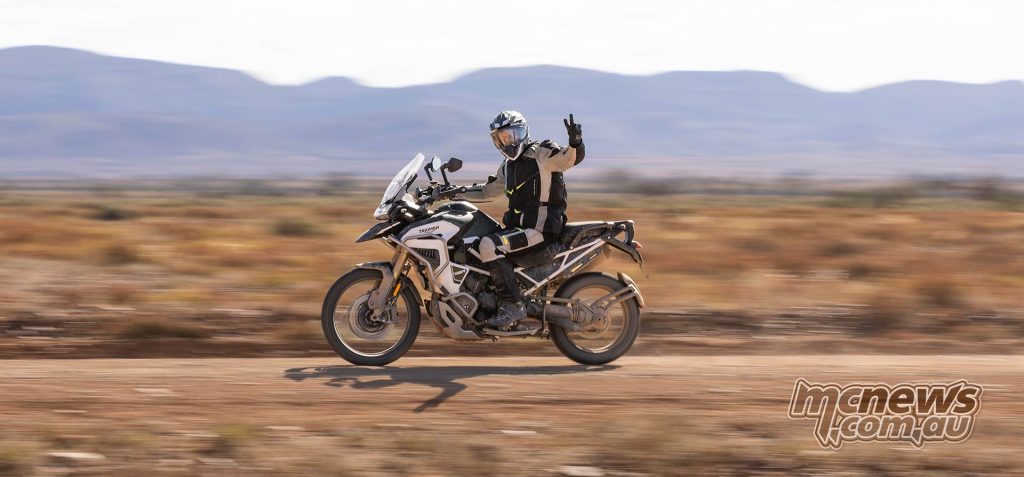
The final day was the one I’d been a bit nervous about if I’m honest. It was our biggest sand day through the Danggali Conservation Park – and I’m very much a sand novice. So I found myself looking at what were now fairly second-hand rear tyre and starting to question the amount of skids I’d been dropping. Turns out I needn’t have stressed too much as we’d been blessed again by the weather and road maintenance gods. The tracks were in great condition and a sprinkling of rain earlier that morning had conditions as close to perfect as you’ll ever get. Only a handful of stretches with anything beyond say 10 centimetres (four inches for you Americans) of soft sand. It was epic. Weight back, throttle on, try not to tense up so the suspension can do its thing. I say try.. as I know I didn’t get it right all the time, but the bike was so forgiving. I wouldn’t call me a sand natural just yet, but there were parts of it that were huge fun.
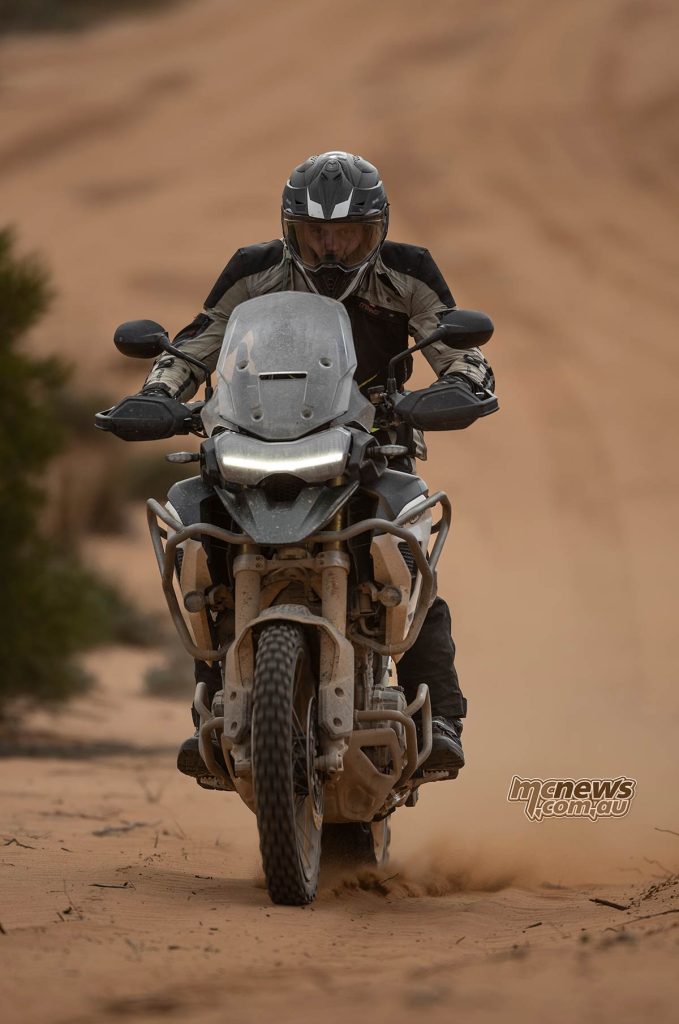
Range-wise, I managed a genuine 351 kilometres on this day on the smaller tanked Rally Pro before the fuel range read zero, and I’m reliably informed that there’s around another 40 kms in reserve once zero has been reached. So.. it’ll get you places.
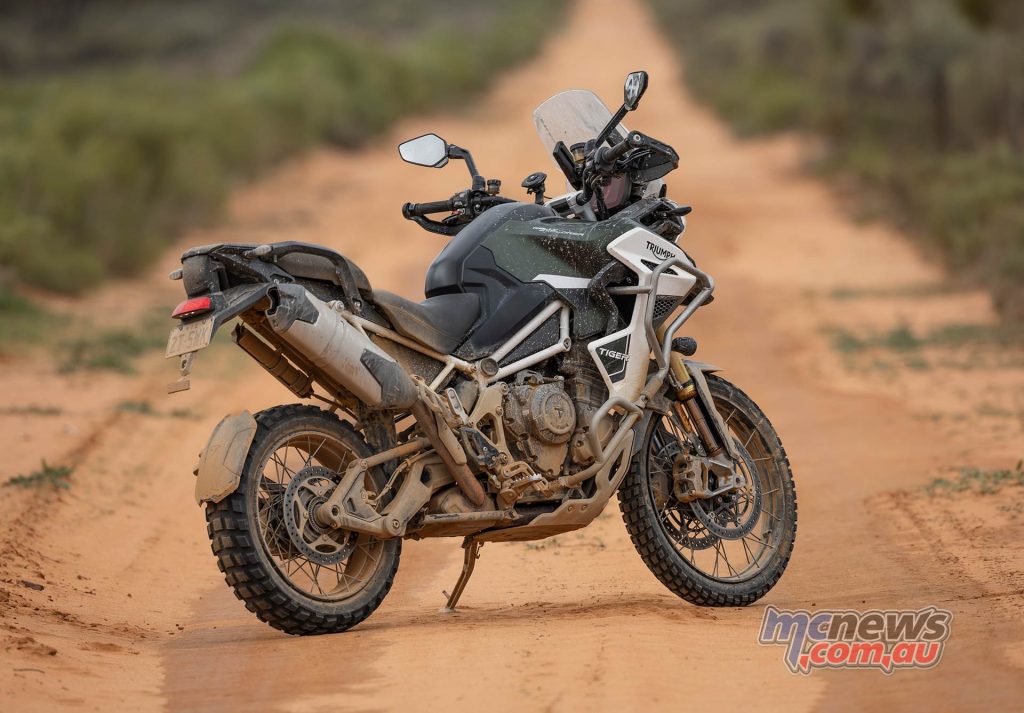
And then suddenly, just like that, we rolled into Mildura. Our week of riding was done. We’d put the new Tiger 1200 through its paces and it had come up Trumps. All things considered I reckon they’ve nailed it. It’s as good a full size Adventure bike as you’ll find.
Pretty sharply priced too, with the Rally Pro coming in at 32 grand and the Explorer at 34. That compares well to the competition, especially when you consider standard equipment, because it comes PACKED.
STANDARD equipment on the Rally Pro:
- 20 L tank for 350 – 400 km range
- 7 inch TFT with lovely new design based on the Speed Triple dash treatment
- Cruise control, centre stand, crash bars, heated grips, hand guards, sump guard, LED adaptive cornering lights, auxiliary lights, cornering optimised traction control, hill hold, shift assist (Triumph’s quick shifter)
- And all electronics standard (as in you don’t pay extra for off road pro mode).
And on top of that, the Explorer also gets:
- 30 L tank for 500 – 600 km range
- Extended crash bars that cover the fuel tank
- Heated seat (both rider and pillion)
- Blind spot radar with mirror mounted indicator
If that isn’t enough – it has 16,000 km service intervals, and a full three year warranty, so cost of entry (for the spec) and ownership are properly competitive.
Triumph has well and truly arrived in the full size adventure segment. These guys are on a roll. In my first thoughts on the launch trip video I referenced the terrific balance of the chassis a few times and it only just occurred to me now that the balance of the original 800 was one of the reasons that I ended up buying one. There’s a certain ease and intuitiveness from a great chassis set-up that’s hard to replicate. Seems like it runs in the family…
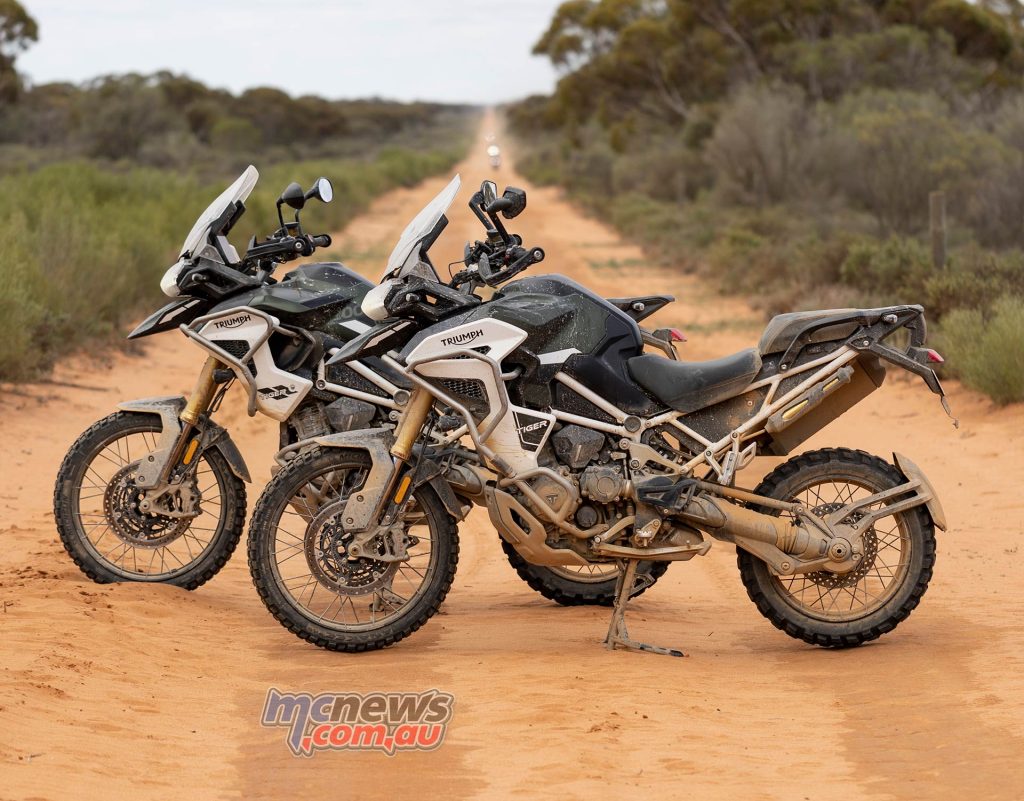
I like the Triumph Tiger 1200 Rally because:
- It’s such a flexible, capable, go anywhere mile eater
- Standing riding position is spot on, the front end is inspiring
- The engine is simply sublime, with a masterful midrange.
- It’s wrapped in a beautifully balanced chassis with excellent suspension
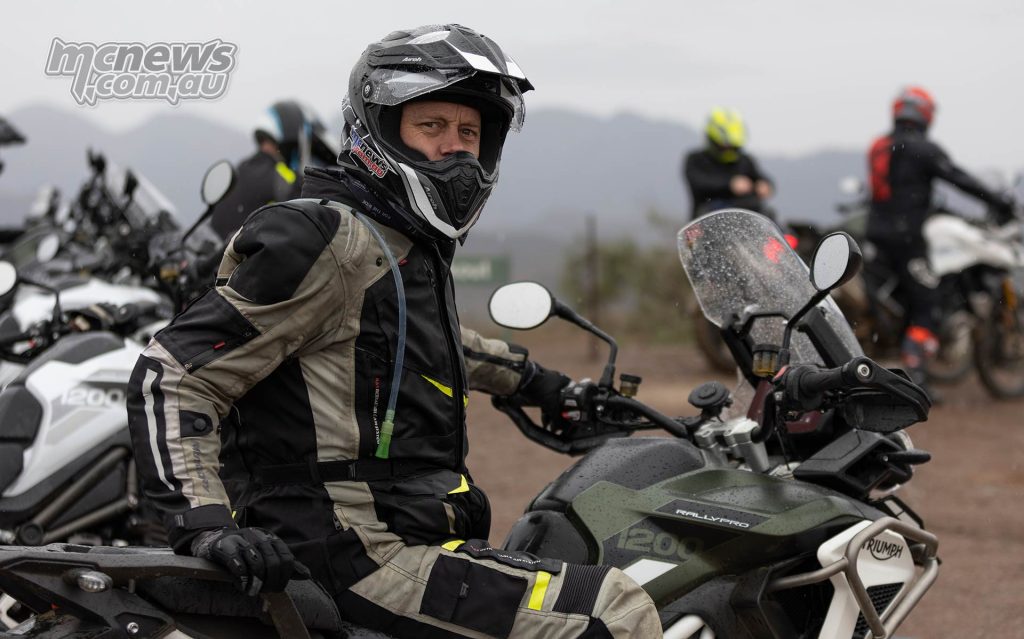
I’d like Tiger 1200 more if:
- Having to stop to flick it in or out of Pro mode (TC and ABS on/off) is annoying
- I’d love to try a version with a slightly stiffer suspension set-up. But it’s close to perfect for 99% of the time.
- As good as the stock exhaust note is, I’d be throwing a slip-on on quick smart if it was mine. That sound. More please 🙂
Tiger 1200 GT family: Tailor made for the perfect road-focused adventure ride, with 19-inch front and 18-inch rear cast aluminium wheels
- Tiger 1200 GT Pro From $29,990 rideaway
- Tiger 1200 GT Explorer From $32,600 rideaway
Tiger 1200 Rally family: Tailor made for the perfect all-terrain adventure, with 21-inch front and 18-inch rear tubeless spoked wheels
- Tiger 1200 Rally Pro From $31,800 rideaway
- Tiger 1200 Rally Explorer From $33,950 rideaway
2022 Triumph Tiger 1200 Specifications
| Specifications | |||||
| Model | GT | GT Pro | GT Explorer | Rally Pro | Rally Explorer |
| Type | Liquid-cooled, 12 valve, DOHC, inline 3-cylinder | ||||
| Capacity | 1160 cc | ||||
| Bore | 90.0 mm | ||||
| Stroke | 60.7 mm | ||||
| Compression | 13.2:1 | ||||
| Maximum Power | 150 PS / 148 bhp (110.4 kW) @ 9,000 rpm | ||||
| Maximum Torque | 130 Nm (96 lbft) @ 7,000 rpm | ||||
| Fuel System | Multipoint sequential electronic fuel injection with electronic throttle control | ||||
| Exhaust | Stainless steel 3 into 1 header system with underslung primary silencer and side mounted secondary silencer | ||||
| Final Drive | Shaft drive | ||||
| Clutch | Hydraulic, wet, multi-plate, slip & assist | ||||
| Gearbox | 6 speed | ||||
| Chassis | |||||
| Model | GT | GT Pro | GT Explorer | Rally Pro | Rally Explorer |
| Frame | Tubular steel frame, with forged aluminium outriggers. Fabricated, bolt-on aluminium rear subframe. | ||||
| Swingarm | Twin sided “Tri-Link” aluminium swingarm with twin aluminium torque arms. | ||||
| Wheels | F – Cast aluminium, 19 x 3.0in. R- Cast aluminium, 18 x 4.25in | F- Spoked (tubeless), 21 x 2.15in. R – Spoked (tubeless), 18 x 4.25in. | |||
| Front Tyre | Metzeler Tourance F – 120/70R19 (M/C 60V TL). R – 150/70R18 (M/C 70V TL) | Metzeler Karoo Street F – 90/90-21 (M/C 54V TL). R – 150/70R18 (M/C 70V TL) | |||
| Front Suspension | Showa 49mm USD forks with semi-active damping. 200mm travel. | Showa 49mm USD forks with semi-active damping. 220mm travel. | |||
| Rear Suspension | Showa monoshock with semi-active damping and automatic electronic preload adjustment. 200mm wheel travel. | Showa monoshock with semi-active damping and automatic electronic preload adjustment. 220mm wheel travel. | |||
| Front Brakes | Brembo M4.30 Stylema monoblock radial calipers, OC-ABS, twin 320mm floating discs. Magura HC1 span adjustable radial master cylinder with separate reservoir. | ||||
| Rear Brakes | Brembo single piston caliper, OC-ABS, single 282mm disc. Rear master cylinder with remote reservoir. | ||||
| Instruments | Full-colour 7” TFT instrument pack with My Triumph Connectivity System | ||||
| Dimensions & Weights | |||||
| Model | GT | GT Pro | GT Explorer | Rally Pro | Rally Explorer |
| Length | 2245 mm | 2245 mm | 2256 mm | 2270 mm | 2296 mm |
| Width | 849 mm (handlebars), 982 mm (handguards) | ||||
| Height Without Mirrors | 1436 – 1497 mm (adjustable screen) | 1487 – 1547 mm (adjustable screen) | |||
| Seat Height | 850 – 870 mm (adjustable) | 875-895 mm (adjustable) | |||
| Wheelbase | 1560 mm | ||||
| Rake / Trail | 24.1° / 120 mm | 23.7° / 112 mm | |||
| Wet weight* | 240 kg | 245 kg | 255 kg | 249 kg | 261 kg |
| Fuel Tank Capacity | 20 litres | 20 litres | 30 litres | 20 litres | 30 litres |
